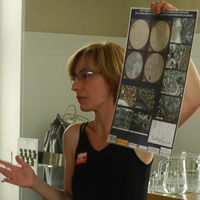
Wojciech Bartz
Address: Wroclaw, Dolnośląskie, Poland
less
Related Authors
Amr M A Osman
Sohag University
Jacek Kościuk
University of Warsaw
Muḥammad ʻAbd al-Sattār ʻUthmān
Sohag University
Elena Mercedes Pérez-Monserrat
Università degli Studi di Padova
RAFAEL FORT
CSIC (Consejo Superior de Investigaciones Científicas-Spanish National Research Council)
Moritz Kinzel
German Archaeological Institute
InterestsView All (10)






Uploads
Papers by Wojciech Bartz
(Neolithic and Early Bronze Age) inhabiting the
Kujawy region of the Polish Lowlands (Central
Poland) were studied. The main goal of this study was
to assess the provenance of the basaltic raw material
and the documentation of manifestations of the activity
of inhabitants of the Lowlands. The mineral and chemical
compositions of the artefacts were directly compared
with those of basaltoids considered as a potential
raw material. The basic discrimination feature that
allowed an unambiguous correlation of the artefacts
with their source region was copper and silica mineralization
present exclusively in the basaltoids from Volyn
(western Ukraine). Moreover, it excludes the provenance
of the basaltic raw material from Lower Silesia
(south-west Poland) and Scania (southern Sweden).
Usage of the basaltic raw material from Volyn was
most probably based on cultural and processual presumptions,
such as migrations of a population(s) from
the Upland regions and/or manifestations of relatively
permanent participation of the local population in
interregional contacts and long-term, long-distance
exchange of items.
(Neolithic and Early Bronze Age) inhabiting the
Kujawy region of the Polish Lowlands (Central
Poland) were studied. The main goal of this study was
to assess the provenance of the basaltic raw material
and the documentation of manifestations of the activity
of inhabitants of the Lowlands. The mineral and chemical
compositions of the artefacts were directly compared
with those of basaltoids considered as a potential
raw material. The basic discrimination feature that
allowed an unambiguous correlation of the artefacts
with their source region was copper and silica mineralization
present exclusively in the basaltoids from Volyn
(western Ukraine). Moreover, it excludes the provenance
of the basaltic raw material from Lower Silesia
(south-west Poland) and Scania (southern Sweden).
Usage of the basaltic raw material from Volyn was
most probably based on cultural and processual presumptions,
such as migrations of a population(s) from
the Upland regions and/or manifestations of relatively
permanent participation of the local population in
interregional contacts and long-term, long-distance
exchange of items.